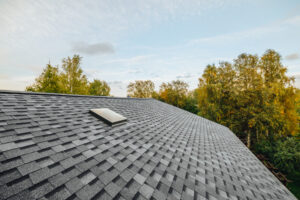
If you’ve been researching various roofing materials, you have probably come across something called “roof fire ratings.” These ratings were established for the purpose of building code and insurance requirement compliance. In fact, some insurance companies may even offer policy discounts for homes with more fire-resistant roofs. Allow our Maryland roof replacement pros to help you understand how to decipher these fire ratings and which one to go with.
How Fire Resistance is Measured
The roof fire ratings grade roofing materials based on fire resistance from internal and external sources. Internal sources mean that fire started inside the house and has entered the attic, heating the roof from underneath. External sources mean that a fire may have spread from another home through the roof, so the roof is being heated from the top. In order to receive a grade, a roof system gets subjected to controlled fire tests. These tests are designed to reveal how well the roof covering stays in position, protects the roof deck and how far the flame spreads.
The 3 most common tests used to evaluate fire resistance of roof coverings include:
- The spread of flame test measures how far the flame spreads on the surface of the roof and whether any part of the roof ignites. This test is typically used on non-combustible roof decks such as steel or concrete.
- The burning brand test measures how well roof covering protects the roof deck from a burning piece of wood that is allowed to sit on top of it until fully burnt through.
- The intermittent flame test measures how well roof covering responds to repeat exposure to heat.
Watch this video demonstrating two of the three tests and their significance:
As a result of these external tests, three fire ratings are assigned to roofing materials: Class A, Class B and Class C.
Class A Roof Coverings
These materials are effective against severe fire test exposure, allow a flame spread of up to 6 feet, withstand a burning brand of 2,000 grams and resists at least 15 cycles of intermittent flame.
Class B Roof Coverings
These materials are effective against moderate fire test exposure, allow a flame spread of up to 8 feet, withstand a burning brand of 500 grams and resist at least 8 cycles of intermittent flame.
Class C Roof Coverings
These materials are effective against light fire test exposure, allow a flame spread of up to 13 feet, withstand a burning brand of 9.25 grams and resist at least 3 cycles of intermittent flame.
What About Class 1?
If you’ve also encountered Class 1 roofing in your research, you are probably getting confused by now. How does Class 1 fit with A, B and C? The truth is, Class 1 is part of an entirely different rating system that measures how well roofing materials respond to the fire that comes from below. This system also measures such things as corrosion and impact resistance, foot traffic and similar characteristics. Generally speaking, a Class 1 roof system can be used in place of a Class A, B or C system, but not vice versa.
Why Roof Fire Ratings Are Important
Installing a roof system with a high fire rating doesn’t mean that your home will be immune to fire. However, if a fire does happen, a Class A or Class 1 roof will help contain the fire from spreading, giving enough time for the firefighters to arrive. This could mean the difference between having to replace your roof and and losing your entire home. But keep in mind that fire ratings alone don’t say much about the roof’s durability or efficiency. Be sure to discuss this with your Maryland roofing contractor, so that we can recommend the best solution for your needs!




